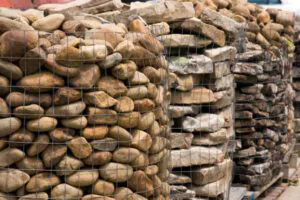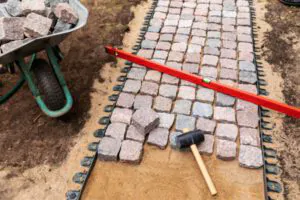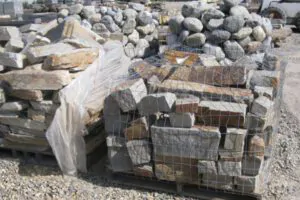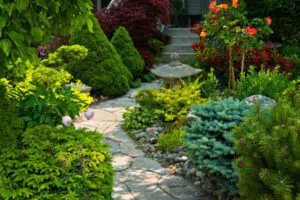Welcome to the transformative world of landscaping rocks, where each stone carries the potential to turn your yard into a masterpiece of design. Often overlooked in favor of greenery and blooms, these natural treasures are the unsung heroes that can provide your garden with structure, texture, and color.
Rocks for landscaping are not just ornamental; they’re multi-functional elements that conserve soil moisture and reduce weed growth while offering endurance against time and weather-relentless cycles.

Imagine creating an oasis that captivates through seasons without demanding constant care – this is what mastering the use of rocks can accomplish for your outdoor space. Keep reading to unearth an array of rock options perfectly suited for crafting your idyllic landscape vision.
Let’s dive in!
Understanding the Basics
Rocks play a key role in your yard’s design, offering both aesthetic beauty and functional benefits.
To pick the perfect stones for your space, start by learning about their various forms and uses. Think of rocks as building blocks that can create paths, and borders, or even act as focal points in your rock garden front yard.
Knowing different types of rocks for landscaping will help you make an educated decision on which ones suit your vision best. Each type brings its own color, texture, and size options to the table.
With this knowledge in hand, you’ll be able to craft a harmonious look that complements your outdoor living area while ensuring durability against the elements. From smooth river rocks that add a tranquil feel to sharp-edged limestone that offers dramatic flair—understanding these basics is crucial for any successful landscaping project.
Benefits of Adding the Right Type of Rocks

Adding rocks to your garden can contribute to the overall aesthetics, functionality, and health of your outdoor space. The right type of rocks can create a visually pleasing and natural-looking landscape while offering several other special benefits.
Drainage
Rocks can provide excellent drainage. Incorporating rocks into your garden beds or as a layer under the soil can help prevent waterlogged soil, which can lead to root rot and other plant diseases. The porous nature of many types of rocks allows rainwater to percolate through them, facilitating a healthier root system for your plants.
Related Post: Spray VS. Drip Irrigation Systems
Rock Mulch
Rocks can act as a natural mulch. Placing rocks around the base of your plants helps prevent weed growth by reducing sun exposure, and limiting weed germination. Additionally, rocks act as a barrier to retain soil moisture, reducing the need for frequent watering. This mulching effect can save you time and effort in maintaining your zen garden, as well as conserve water in dry climates.
Stunning Landscape
Rocks can enhance the beauty of your garden and create a sense of harmony with nature. They can be used to build engaging pathways, create borders, or add interest to rock landscapes or water features. The variety of colors, textures, and sizes available in rocks allows for endless possibilities in garden design, lending a unique character to your outdoor space.
Lastly, rocks are durable and long-lasting additions to your garden. Unlike other landscaping materials like mulch or wood chips, rocks do not decompose over time. This means that once installed, rocks require minimal maintenance, allowing you to enjoy low-maintenance garden paths that retain their beauty for years to come.
Incorporating the right type of rocks into your garden can offer numerous benefits. From better drainage and weed control to enhancing the overall aesthetics and requiring minimal maintenance, rocks can be a valuable addition to your outdoor space. So why not explore the wide variety of rocks available and see how they can transform your garden into a beautiful, functional, and sustainable oasis?
You might like: What Plants Do Well In New Mexico?
Exploring the Most Popular Types of Landscaping Rocks
Discover the beauty and versatility of river rocks, limestone, pea gravel, and decomposed granite for your landscaping needs. Each type offers unique characteristics that can enhance the visual appeal of your outdoor space.

River Rocks
River rocks are a favorite among garden enthusiasts and landscape designers. These smooth, rounded stones come from years of erosion due to river water currents, giving them a polished look that can add tranquility to any outdoor space.
You’ll find them in various sizes, from small pebbles to larger stones, making them versatile for different design needs.
Use these natural beauties to create pathways through your garden or as an attractive border around flower beds and ponds. Their variety of colors blends well with many plants and other landscaping elements.
Additionally, river rocks are durable and require minimal maintenance, staying put through heavy rain or wind. Add these elegant stones to your landscape for a touch of nature’s serenity amidst the greens of your backyard oasis.
Limestone
Limestone stands out for its ability to enhance a classic and natural look in your garden. This rock comes in shades of white, gray, and tan, offering a soft color palette that complements greenery perfectly.
Its durability makes it ideal for patios, walkways, or as decorative edging around flower beds. You can find limestone in various sizes from small pebbles to large slabs suitable for different landscaping projects.
Choose limestone if you’re going for an elegant yet understated aesthetic in your outdoor space. Besides adding beauty, this rock helps maintain soil pH balance, which can encourage healthier plant growth.
It’s also great for creating a pathway with flat surfaces that provide a stable footing while walking through the garden.
Pea Gravel
Transitioning from the smooth and elegant appeal of limestone, let’s turn our attention to pea gravel. This type of rock is not only popular for landscaping but also incredibly versatile.
Pea gravel is known for its small, rounded shape, making it ideal for pathways and walkways due to its comfortable texture underfoot. It also provides excellent drainage, making it a practical choice for areas prone to heavy rainfall or flooding.
Pea gravel comes in various colors such as beige, gray, white, and translucent options that add an aesthetic touch to any garden or landscape project. It pairs well with other types of rocks and landscaping elements while offering a cost-effective solution for creating visually appealing outdoor spaces.
Decomposed Granite
Decomposed granite, a popular choice for landscaping compared to granite gravel, offers a rustic and natural look due to its earthy tone and fine texture. It is versatile and can be used for pathways, driveways, or as ground cover in gardens.
Its durability makes it ideal for high-traffic areas, and its ability to compact tightly provides stable footing. As it decomposes over time, it helps improve soil drainage while also being relatively low-maintenance.
Small uses of decomposed granite will provide an excellent contrast with colorful plantings and other rocks or boulders. It adds visual interest to the landscape project with its subtly varied color palette ranging from golden hues to reddish-browns.
Related Post: The Difference Between Formal And Informal Landscape Design
Landscape Aesthetics with the Right Rocks
Enhance the visual appeal of your landscape by choosing the right rocks that complement your design theme. From creating focal points with boulders to blending colors and textures, there are various ways to use rocks for aesthetic purposes in landscaping.
Matching rock types with landscape design themes
Choosing the right type of rocks for your landscape design can significantly impact the overall aesthetic. For a modern and sleek look, consider using smooth river rocks or limestone.
If you’re aiming for a more natural and rustic feel, then opt for decomposed granite or pea gravel. The key is to match the textures and colors of the rocks with your desired design theme to create a cohesive and visually appealing outdoor space.
Additionally, creating focal points with boulders and large rocks can add drama and interest to your landscape design. Use them strategically to draw attention to specific areas of your yard or garden.
By blending different landscape rocks, colors, and textures, you can enhance the visual appeal of your outdoor space while adding depth and dimension.
Creating focal points with boulders and large rocks
Transitioning from matching rock types with landscape design themes, incorporating boulders and large rocks can create striking focal points in your landscaping. Strategically placing these larger elements draws attention and adds visual interest to your outdoor space.
Boulders can serve as eye-catching centerpieces, while large rocks can be used to define borders or pathways, enhancing the overall aesthetic of your landscape design.
Blending colors and textures for visual appeal
Blending various colors and textures of rocks can add visual interest to your landscape design. Mixing different types of rocks, such as river rocks, limestone, and pea gravel, creates a dynamic and eye-catching look.
Combining larger boulders with smaller pebbles or crushed granite adds depth and dimension to your outdoor space.
Layering various landscape rocks in different shades and sizes can create a natural and visually appealing effect. Additionally, integrating contrasting textures like smooth river rocks with rougher decomposed granite can provide an interesting tactile experience while enhancing the overall aesthetic appeal of your landscaping.
Considerations for Selecting Rocks for Your Landscape

When selecting rocks for your landscape, it’s important to consider the durability and weather resistance of different landscape rocks. You’ll also want to think about the maintenance requirements and suitability for specific landscaping applications to ensure you choose the right rocks for your outdoor space.
Durability and weather resistance of different rocks
Different rocks offer varying levels of durability and weather resistance, which are crucial factors to consider for landscaping. For instance, granite is known for its exceptional durability and ability to withstand harsh weather conditions.
Limestone, while visually appealing, may not be as resistant to weathering as granite. River rocks are durable but can degrade over time due to exposure to the elements. Understanding the specific characteristics of each landscape rock in terms of durability and weather resistance will help you make an informed decision when selecting rocks for your landscape.
Maintenance requirements for various rock types
Limestone requires occasional cleaning to maintain its appearance. Sweep away debris and rinse with water as needed. For pea gravel, raking regularly keeps the surface level and prevents weed growth.
River rocks typically need minimal maintenance but may benefit from occasional rinsing to remove dust or dirt buildup. Decomposed granite should be occasionally compacted to keep a smooth surface.
When choosing landscaping rocks, consider the effort required to maintain their appearance over time. Different landscape rocks have unique care needs, so select ones that align with your maintenance preferences and capabilities for the long-term enjoyment of your landscape design.
Suitability for specific landscaping applications
Different types of rocks offer unique advantages when it comes to specific landscaping applications. River rocks are well-suited for water features and erosion control due to their smooth texture and natural appearance.
Limestone, with its durability and versatility, works best for pathways, patios, and retaining walls. Pea gravel is excellent for creating walkways or filling in between larger stones in the garden.
Decomposed granite is ideal for creating stable and functional surfaces in areas where drainage is a concern, such as driveways or paths.
Conclusion
In conclusion, you’ve gained insight into various types of rocks for landscaping. By considering factors such as durability and maintenance, you can make informed choices. Emphasizing practicality and efficiency enables you to enhance your landscape with the right rocks.
How will you incorporate these strategies into your landscaping plans? Enhance the aesthetics and functionality of your outdoor space with carefully selected rocks. Your choice of landscaping rocks can significantly impact the overall appeal and ambiance of your outdoor environment.
If you’re looking for the pros in landscaping to give you some advice on which rocks to use, contact Evergreen Landscape Pros. With years of experience and in-depth knowledge of landscaping, we are the professionals to call. Call our Santa Fe Landscapers now and let us help you choose the best landscaping rocks for your garden.





